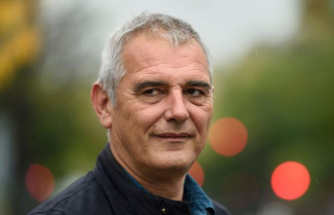One of the key skills of HIV is its capacity to hide, to seek refuge in hiding-places where it remains latent. It is for this reason that hiv-positive people must take antiretrovirals for life because, if you let them, the virus re-emerge with force.
In their search for a cure against the infection, scientists take the time to analyze the role of stem cell transplants. This strategy is propelled after that in 2008, Timothy Brown, better known as the 'patient Berlin' , managed to overcome the disease after undergoing a bone marrow transplant to treat leukemia who also suffered.
In this case, the success of the treatment was associated to a particularity of the donor, a genetic mutation that seems to be the key to prevent the virus 'atrinchere' in the body.
But there could be other factors associated with the transplantation of stem cells capable to contribute to the elimination of these reservoirs. So suggests research published in the Annals of Internal Medicine, led by scientists from the Institute for aids Research IrsiCaixa of Barcelona and the Gregorio Marañón Hospital in Madrid.
As they explain, their research has shown that, after receiving a stem cell transplant, five patients had a reservoir of HIV undetectable. One of them also showed antibodies against the virus in the blood, a parameter that always stays on the affected. All of them maintained over the whole process, the treatment with anti-retrovirals, explain.
The finding, the researchers say, "could serve for the design of strategies to cure HIV less invasive". Currently, the stem cell transplant is recommended exclusively to treat hematologic diseases severe.
To carry out the research, the scientists analyzed a cohort of HIV-infected persons who had undergone a transplant to treat various hematologic diseases who were suffering from.
the goal of The team was to check whether, apart from the mutation associated with the healing of the 'patient Berlin' -so-called CCR5 Delta 32-, other mechanisms associated with transplantation may also influence the eradication of HIV.
The study included 6 participants (three in Madrid, two in Granada and one of Milan) who had survived at least 2 years after receiving the transplant, and they were not receiving immunosuppressive medication. All donors lacking the mutation CCR5 Delta 32 in their cells, because the intention of the researchers was, precisely, to look at other possible causes associated with the transplant.
After the transplantation, all participants had antiretroviral therapy and had achieved remission of their hematological disease after the withdrawal of the immunosuppressive drugs. But they also shared another common feature: in all of them there had been a rejection of the donor cells.
at this point, the scientists conducted various tests and found that in five of the six patients, the virus was undetectable in all the 'hiding spots' common in the blood and tissues. In one of these five, additionally, the antibodies to the virus had completely disappeared seven years after transplantation.
According to Maria Salgado, a researcher at IrsiCaixa and author of the work, "this fact might be a proof that the HIV infection is in her blood, but this only can be confirmed by stopping the treatment and seeing if the virus reappears or not", reports Efe.
Matches in stressing this point, José Luis Díez, chief of the Hematology service of Hospital Gregorio Marañón and another of the research leaders, who clarifies that you still can't say that the virus has been eradicated. "To prove the point, it is necessary to do a clinical trial in which you discontinue the medication with antiretroviral drugs under close monitoring. So you can check if the virus re-emerges". The study of the evolution of the patients should be in the medium-long term, as there have been cases of viral rebound after many months in which the infection seemed to be eradicated, he adds.
In the words of Diez are, in this case could have contributed to the possible good resolution of the approach to various factors. For example, it was key to the speed with which he performed the transplantation of stem cells, indicates.
Of the six patients studied, the only one who yes kept a reservoir of HIV detectable was the one who had received a transplant of umbilical cord blood (the rest were of bone marrow), which, by the characteristics of the transplant, it took more time in getting the donor cells replaced in your body to your own. "We have seen that, the shorter that period is, the more effective is the reduction of the reservoir".
Another key is the graft versus host disease, a usual effect after the transplant occurs when the donor cells attack the recipient, and that also contributes to the removal of the tumors caused by hematological diseases.
All patients who achieved that the virus is not detected in the reservoirs usual having a reaction, although he was able to be controlled before generating major complications. "This suggests that if we can control this effect so that it is not fatal, it can contribute to destroy the cells as the viral reservoir," notes Díez.
"we have Not seen this effect on the reservoirs of the virus with any other treatment, but we can not speak of success until we put in place the clinical trial," warns Diaz. If all goes well, the study will begin in 2019 and will last at least a year.
Some experts agree with this view of the researcher of the Gregorio Maranon: it is Still too early to talk about a treatment based on this finding. "It is not for nothing transplantable or even a small part of the population with HIV," says Esteban Martinez Chamorro, secretary of GeSIDA, the study group of the Spanish Society of Clinical Microbiology and Infectious Diseases.
patients who have come to these treatment have traveled a long and dangerous journey. Have had a blood cancers; and have received a transplant more of a conditioning with chemo or radiation therapy, all with a risk of mortality very high. In fact, the patients included in the study; they had been lucky to survive more than two years. Finally, and paradoxically, the more beneficial to control the infection by HIV is the cause of a rejection," explains Martínez Chamorro. "Rejection is an undesirable effect of the transplant. Requires an immunosuppressive therapy, because, otherwise, the immune system transplantado will promote a response in different organs and tissues, which can lead to digestive problems, skin, liver,... and the price Is extremely high as treatment," he says.
however, despite the preliminary results, the secretary of GeSIDA recognizes the scientific value of the research. "What can you bring are new knowledge about the mechanisms in these patients are related to viral control, and see if these mechanisms can be isolated and used without having to suffer all the evil of the process," he says.
Date Of Update: 30 October 2018, 07:00











